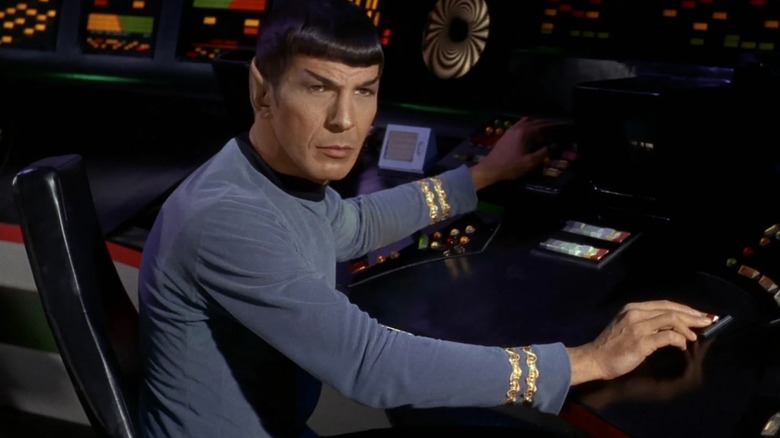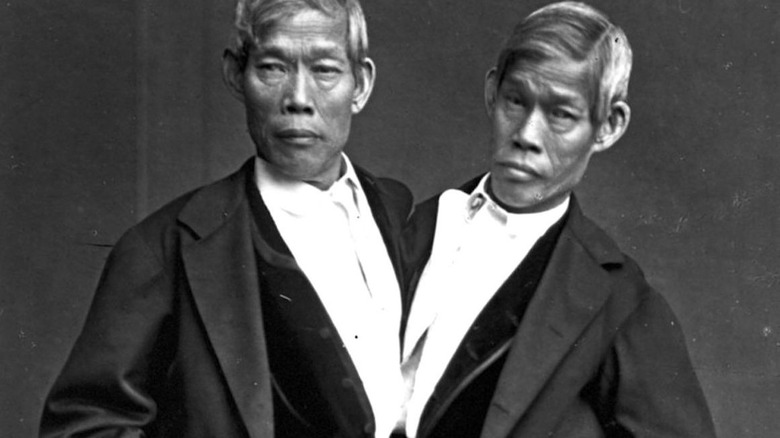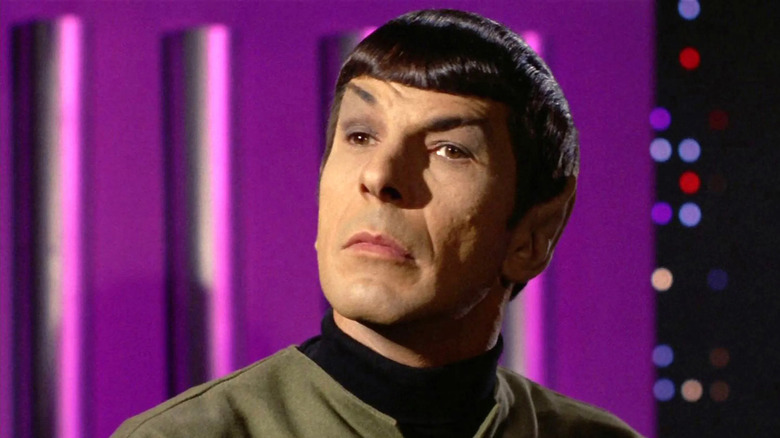Spock's Green Blood In Star Trek Inspired A Very Elaborate Practical Joke
Spock (Leonard Nimoy) was perhaps the most striking and memorable character from "Star Trek," back when it first started to take off in syndication in the early 1970s. On a ship full of humans, Spock was half-human and half-Vulcan. He had angled eyebrows and pointed, Mephistophelean ears. It's also noted throughout the season that Spock has green blood (although he never bleeds green on camera), and McCoy (DeForest Kelley) once noted that Spock's heart "is where his liver should be." Spock is also stronger than a human, very long-lived (Vulcans can live to age 250), and has a much more sophisticated brain than a human's; Vulcans are intimidatingly intelligent.
The fact that Spock has green blood, however, wasn't merely a whim of "Star Trek" creator Gene Roddenberry. It seems that Roddenberry once visited the famed Mütter Museum, a curious medical archive located inside the College of Physicians in Philadelphia, Pennsylvania. The museum contains defunct medical instruments as well as a host of curios and medical abnormalities, carefully displayed for reasons of biological study. The museum famously contains a full-body cast of Chang and Eng Bunker, the famous pair of conjoined twins who became celebrities in the 1830s. Because they were born in what was then called the Kingdom of Siam (now Thailand), they became known as Siamese Twins, and for many years, the term came to be associated with all conjoined twins.
Roddenberry had an interest in pathological medicine and a video put out by the Mütter Museum – posted on April 1, 2019 — explained that Roddenberry once gave a (curiously lost) interview about "Star Trek" that related to Chang and Eng. According to the Mütter Museum, Roddenberry read an autopsy report after the Bunker brothers' death in 1874 that claimed the twins' blood was green.
Chang and Eng and Spock
According to the Mütter Museum's video, the Bunker brothers' autopsy was conducted at the museum back in 1874. The report that Gene Roddenberry allegedly looked at is also one of the pieces of medical ephemera in their collection. Scans of the report can be found online. From the report (at least according to the video):
"The right side of [Eng's] heart was occupied by a greenish, soft, grumous clot much smaller than was found in the same locality in Chang. The green-black blood had the odor of sulfur. The heart of Chang presented a right auricle and ventricle distended with a dense green venous clot, extended from the right ventricle along the pulmonary arteries."
The video's host, the Mütter Museum's director Robert Hicks, said the Bunkers' autopsy was difficult, given that they were connected by a four-inch band of flesh on their chests. The two brothers partially shared a liver, a liver that Chang harmed with alcohol abuse. Hicks pointed out that the Bunkers' conjoined livers are also on display at the museum.
He also produced a mysterious vial, an artifact he claimed was left over from 1874, and one that contained the dried remnants of what was supposed to be the twins' bright green blood. The bottle was supposedly filled by Dr. Harrison Allen, the man who wrote the Bunkers' autopsy report. Dr. Allen, Hicks said, posited that the green blood was a result of an ineffable mix of chemicals.
But is that actually the blood of Chang and Eng? Is it even medically possible to have green blood? The answer is a resounding, "Well, I guess it's possible."
'Live long and prosper, my dear son.'
In 2007, according to an article in the Lancet, a man in Canada had recently given a blood sample at a hospital and his blood came out blackish green. It seems he had a condition called sulfhemoglobinemia. Thanks to certain drugs, sulfur can make its way into your red blood cells, causing them to turn green. So, yes, it seems medically possible that Chang and Eng had dark green blood at the time of their deaths.
The story of Chang and Eng's death is perhaps well-known to people familiar with the twins. Chang is said to have died in his bed, having fallen into ill health. Eng was said to have died two hours later. Dr. Allen posited that Eng died of fright; being attached to one's deceased brother for two hours does indeed seem harrowing. This claim has, of course, been disputed.
But — according to an impish Robert Hicks — a "Star Trek"-related detail was perhaps recorded in Dr. Allen's report that Gene Roddenberry would certainly have latched onto. According to the video's version of the report, Eng knew he was dying after Chang's death and called in his (sizeable) family to bid them farewell. Dr. Allen noted that Eng's last words were "Live long and prosper, my dear son!"
Of course, looking at the actual report reveals that Eng's last words were, in fact, "May God have mercy on my soul!" Also, all the references to green blood seem to be absent. Did Hicks get it wrong?
Well, it seems that the video in question was posted on April 1, 2019.
Head-desk.
Yes, the final Vulcan words of Eng, the brother's allegedly green blood, and Dr. Allen's vial were nothing more than an elaborate April Fool's Day prank.
Gotchya.


